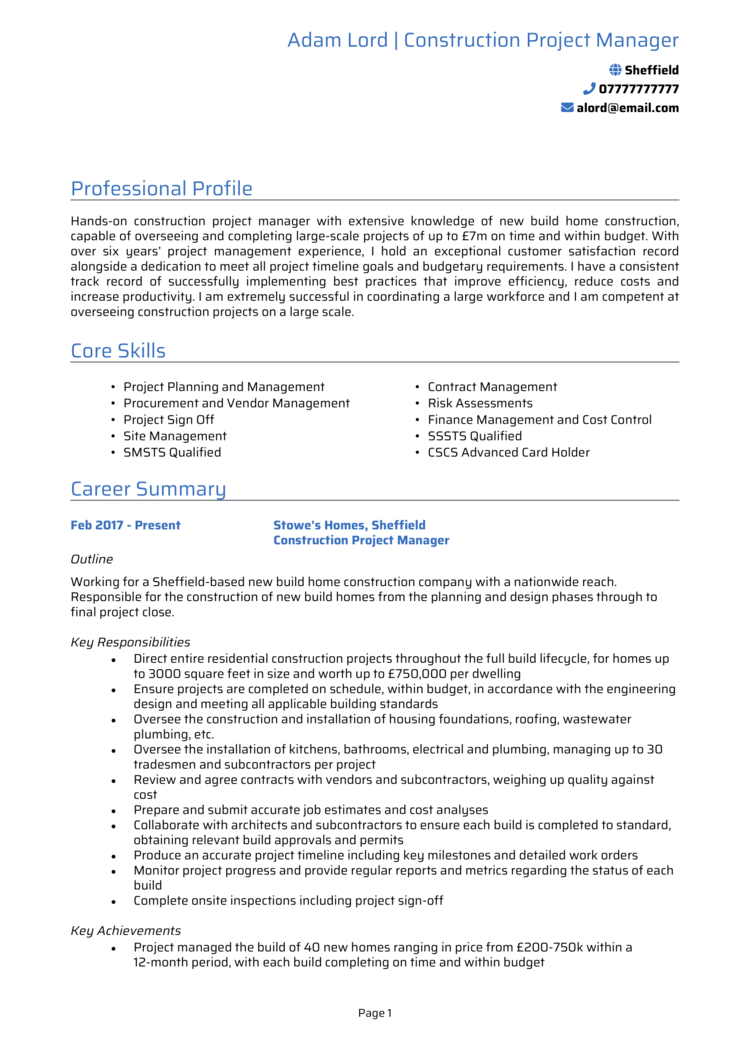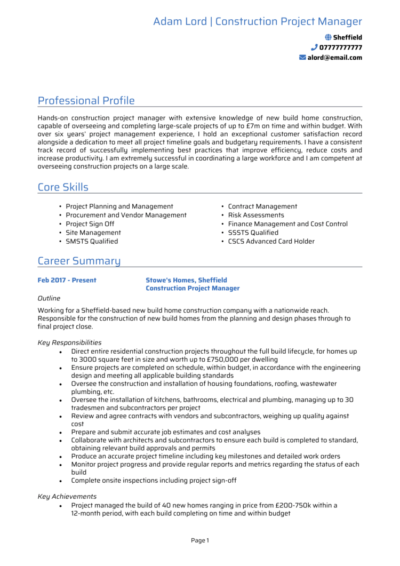Ever felt like you can manage multi-million-pound builds, juggle contractors, and solve site problems in your sleep – but still can’t seem to land interviews?
You’re not alone. A strong track record on-site won’t mean much if your CV looks like it was thrown together during a coffee break.
This guide (complete with a Construction Manager CV example) will show you how to write a CV that’s as solid as your project foundations – helping you land better roles and more rewarding contracts.
Construction Manager CV sample

How to write your Construction Manager CV
Discover how to craft a winning Construction Manager CV that lands interviews with this simple step-by-step guide.
This guide takes you through everything needed to build a standout construction manager CV – from formatting it correctly to writing content that highlights your leadership and technical expertise.
Each section is designed to help with writing a CV effectively and showcase the experience that matters most to employers in the construction industry.
How should you structure and format a Construction Manager CV?


Construction is all about planning and clean execution – and your CV should be no different. A clear CV structure helps employers quickly assess your qualifications, leadership experience, and technical skills without digging through disorganised content. If they’re overwhelmed by visual mistakes and blocks of text, they’re just going to move onto the next candidate.
Here’s the layout to follow:
- Name and contact details – Keep these personal details at the top so a potential employer can reach out to you.
- Profile – Immediately draw in the recruiter with a brief summary of your skills and experience.
- Core skills – Quickly list your biggest strengths for the role.
- Work experience – Walk through your employment history in reverse chronological order.
- Education – List the qualifications and certificates that make you the right fit.
- Additional info – You can optionally list any relevant hobbies and interests which help to convey your suitability.
A messy CV format is like a job site without blueprints – chaotic and easy to abandon. Use bullet points to break up large blocks of text, separate each section with clear headings, and stick to a font that looks professional and is easy to read. Aim to keep your CV to 2 pages or less, giving enough length to impress without exhausting the reader. Following these tips will help impress recruiters before they even start reading.
Writing a Construction Manager CV profile


A CV profile is the short, punchy paragraph at the top of your CV – your best chance to quickly show recruiters why you’re the Construction Manager they’ve been looking for. It’s your first impression, so make it count by highlighting your experience and industry expertise in just a few lines.
This section should focus on the value you bring to a construction project – whether that’s delivering builds on time and under budget, leading large site teams, or managing health and safety without compromise. Aim to reflect the qualities in the job advert and tailor your wording accordingly.
Construction Manager CV profile examples
Profile 1
Experienced Construction Manager with over nine years of experience overseeing commercial, residential, and infrastructure projects from groundworks to handover. Skilled in site coordination, contractor management, and health and safety compliance. Proficient in using project management tools such as MS Project and Procore. Known for delivering projects on time and within budget while maintaining high standards of quality and safety.
Profile 2
Results-driven Construction Manager with eight years of experience leading on-site operations across housing developments and mixed-use builds. Strong background in subcontractor coordination, scheduling, and quality control. Experienced in liaising with clients, architects, and engineers to ensure design specifications are met and deadlines are maintained.
Profile 3
Detail-focused Construction Manager with ten years in the industry, managing both public sector and private builds including schools, retail units, and infrastructure upgrades. Adept at site logistics, risk assessments, and team leadership. Committed to delivering safe, efficient, and regulation-compliant projects through every phase of construction.
Details to put in your Construction Manager CV profile
To make sure your profile hits the mark, include these key points:
- Where you worked – Mention the kinds of sites or projects you’ve managed, such as residential developments, commercial buildings, or infrastructure projects
- Your top qualifications – Whether you’ve got a degree in construction management, an SMSTS certificate, or a CIOB membership, include it here
- Essential skills – From project planning and budget control to managing subcontractors, mention what you do best
- Project size and scope – Highlight the scale of projects you’ve led, such as multi-million-pound builds or high-rise developments
- Health and safety knowledge – If you’ve overseen compliance with CDM regulations or implemented site-wide safety protocols, be sure to include that
Writing an effective core skills section


A CV skills section is your chance to showcase your most valuable construction management strengths in one quick hit – no waffle or filler, just the essentials. With 4–8 bullet points, it gives recruiters an instant snapshot of your capabilities before they even glance at your work history.
The beauty of this section? It’s quick to customise for different jobs. Whether the role leans heavily on budget control or team leadership, you can easily swap in the most relevant skills to match. And always lean towards technical strengths over vague soft skills – think “project scheduling” not “motivated self-starter.”
The top skills to highlight in your Construction Manager CV
- Project Planning and Scheduling – Developing detailed construction plans, timelines, and milestones to ensure projects stay on track.
- Site Supervision and Coordination – Overseeing daily operations on-site, coordinating contractors, subcontractors, and tradespeople.
- Budget Management and Cost Control – Monitoring expenses, managing project budgets, and controlling costs to maximise profitability.
- Health and Safety Compliance – Enforcing safety regulations, conducting risk assessments, and ensuring all site activities adhere to legal standards.
- Quality Assurance and Control – Inspecting work to ensure it meets design specifications, industry standards, and client expectations.
- Resource Allocation and Procurement – Managing labour, materials, and equipment to support efficient site operations.
- Contract and Documentation Management – Handling contracts, permits, and documentation related to construction activities and legal compliance.
- Stakeholder Communication – Liaising with architects, engineers, clients, and regulatory bodies to provide updates and resolve issues.
- Problem-Solving and Decision Making – Addressing unforeseen challenges and making quick, effective decisions to keep the project on schedule.
- Progress Reporting and KPI Tracking – Producing regular reports on site performance, productivity, and key milestones for senior management.
Showcasing your work experience


Here’s where your CV really gets built from the ground up – your work experience section. It’s the best way to prove you’ve not only got the right skills, but that you’ve actually used them to deliver real achievements on site.
List your roles from most recent to earliest, making sure to give more detail to your latest jobs. Focus on the value you brought to each project, whether that’s cutting costs or delivering on tight deadlines.
And whatever you do, avoid long paragraphs – bullet points are your best friend here, making it easy for busy recruiters to scan through. If you’re just starting out or changing careers, don’t panic. You can still draw from university modules, group projects, placements, or anything else that shows off relevant skills in action.
Writing job descriptions for past roles

- Outline – Describe the employer and your role within the company, including the overall goal of your position. Mention the types of construction projects you worked on, who you reported to, and the teams or departments you coordinated with.
- Responsibilities – Highlight the core duties you were responsible for on each project. Use strong action words and include any specific tools, systems, or construction methods you used to get the job done.
- Achievements – Show the measurable impact you had by including facts and figures where possible – such as budget savings, delivery times, or safety improvements. Recruiters want to see proof that you added real value.
How to present past roles for Construction Manager
Construction Manager | Hawthorne Developments Ltd
Outline
Managed the construction of a 150-unit residential development for a regional property developer, coordinating all on-site activity from initial groundworks to final inspections.
Responsibilities
- Supervised daily site operations, ensuring compliance with drawings and build schedules.
- Liaised with subcontractors, suppliers, and building control officers.
- Conducted toolbox talks and enforced health and safety standards across the site.
- Monitored site budgets and controlled waste, labour, and materials efficiently.
- Reported progress to senior management and resolved site-based issues as they arose.
Achievements
- Completed the project two weeks ahead of schedule with zero major incidents.
- Achieved full NHBC sign-off with minimal defects at handover.
- Recognised by company directors for effective coordination and problem-solving.
Construction Manager | Broadley Infrastructure Group
Outline
Led on-site delivery of a multi-million-pound highway improvement scheme for a civil engineering contractor, coordinating teams, schedules, and external agencies.
Responsibilities
- Planned and managed daily works, including excavation, drainage, and surfacing.
- Oversaw subcontractors and internal labour teams to maintain project milestones.
- Ensured traffic management systems were safely implemented and regularly reviewed.
- Carried out site inspections and prepared RAMS documentation.
- Liaised with local authorities, utility providers, and environmental consultants.
Achievements
- Delivered all phases of the project within agreed timelines and budget allocations.
- Maintained a clean safety record with zero reportable incidents over 18 months.
- Facilitated early stakeholder engagement that helped prevent planning delays.
Construction Manager | Redbridge Projects
Outline
Directed site operations for the build of a 40,000 sq ft office and retail complex, overseeing day-to-day activities and site team performance for a commercial contractor.
Responsibilities
- Coordinated structural steelwork, cladding, and internal fit-out teams.
- Managed site documentation including daily logs, delivery notes, and inspection records.
- Conducted quality checks and ensured works met client and architect specifications.
- Facilitated weekly site meetings with project managers and design consultants.
- Implemented COVID-19 safe working procedures during live phases of the project.
Achievements
- Delivered all works to programme with strong client satisfaction at practical completion.
- Reduced snagging issues by 30% through improved mid-phase inspections.
- Praised for leading a high-performing team and maintaining positive site culture.
Highlighting your education


This section is all about your qualifications – degrees, diplomas, certificates, or any training that proves you’ve got the academic education and technical knowledge to back up your on-site experience.
It’s usually a smaller part of the CV for experienced professionals, since recruiters will be more focused on your work history. That said, if you’re earlier in your career or switching industries, don’t be afraid to highlight relevant coursework or construction-related modules that show your potential.
List your qualifications in reverse chronological order, starting with the most recent – whether it’s a construction management degree, an SMSTS certificate, or a health and safety qualification.
The best qualifications to boost a Construction Manager CV
- CIOB Chartered Membership (MCIOB) – A widely respected accreditation that demonstrates professional competence and leadership in construction management.
- NVQ Level 6 Diploma in Construction Site Management – This vocational qualification proves you have the skills and knowledge to manage construction sites effectively and safely.
- SMSTS (Site Management Safety Training Scheme) – Essential for site managers in the UK, this certificate shows you understand health and safety regulations on construction sites.
- BSc (Hons) Construction Management – An academic degree that provides a strong foundation in project planning, budgeting, and contract management.
- CSCS Black Card (Manager Level) – Validates your experience and qualification level for senior management roles on UK construction sites.





